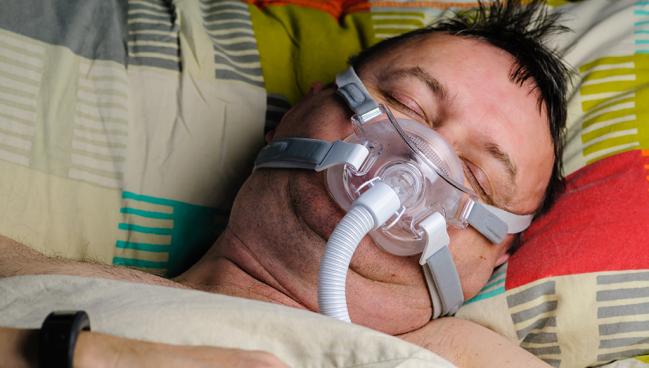Adherence Key to CPAP’s Benefits in Sleep Apnea Patients With CVD
A meta-analysis of three randomized trials shows fewer MACCE when CPAP therapy is used at least 4 hours per night.

For patients with obstructive sleep apnea and cardiovascular disease, adherence seems to be the deciding factor for whether continuous positive airway pressure (CPAP) use is effective at secondary prevention, a meta-analysis suggests. The risk of major adverse cardiac and cerebrovascular events is lower among those who, on average, use their device at least 4 hours nightly.
The results were published online yesterday in JAMA.
Prior studies have shown up to two-thirds of patients with coronary artery disease have obstructive sleep apnea, which can block the flow of oxygen, interrupt rest, and often lead to daytime somnolence.
“We know from the last 25, 30 years, there exists a close relationship between the consequence of obstructive sleep apnea and the promotion of cardiovascular disease,” Manuel Sánchez-de-la-Torre, PhD (Hospital Universitario Arnau de Vilanova-Santa Maria and University of Lleida, Spain), lead author of the paper, told TCTMD.
Indeed, earlier data have hinted at a primary-prevention role for CPAP, with the therapy reducing blood pressure levels. But whether treating the breathing disorder with CPAP would impact outcomes in high-risk patients with established CVD has been unclear.
Sánchez-de-la-Torre and colleagues combined individual participant data from three randomized trials that had been murky on whether CPAP use could be cardioprotective: SAVE, ISAACC, and RICCADSA. Overall, their meta-analysis found no reduction in MACCE—but an on-treatment analysis that focused on sleep apnea patients who used their device at least 4 hours per night showed otherwise.
This, Sánchez-de-la-Torre said, is “the major contribution of our new study.”
At Least 4 Hours
In all, the meta-analysis included 4,186 participants (mean age 61.2 years; 82.1% men), for whom the mean apnea-hypopnea index was 31.2 events per hour. The mean body mass index was 29.9 kg/m2, and 71% had hypertension. Half received CPAP, while the rest got usual care.
The rate of MACCE (a composite of CV death, MI, stroke, revascularization, and hospital admission for heart failure, unstable angina, or TIA) was 16.5% overall. In an intention-to-treat analysis, the risk of first MACCE was similar between the sleep apnea patients who did and did not receive CPAP treatment (HR 1.01; 95% CI 0.87-1.17). But an on-treatment analysis showed that among people who used CPAP for a mean of least 4 hours per night had a significantly reduced risk of MACCE compared with no CPAP (HR 0.69; 95% CI 0.52-0.92).
For clinicians, and for patients, the message is clear, said Sánchez-de-la-Torre: for CPAP to work at secondary prevention, it must be used properly. “The question that remains is: how can we improve the compliance of patients treated with CPAP, which is currently very low?”
In the three RCTs included in the meta-analysis, the median duration of CPAP use per night ranged from 2.2 to 3.3 hours. Notably, due to inclusion criteria, these study participants didn’t suffer from daytime sleepiness.
Clinicians treating such patients without symptoms may find it hard to convince them that they can benefit from better adherence to CPAP, Sánchez-de-la-Torre said. “We have to fight with them. We have to convince them that they have to maintain good adherence to CPAP treatment to avoid cardiovascular complications associated with obstructive sleep apnea.”
How to achieve this is still being worked out, the paper notes, pointing to other potential factors that influence patient adherence, “such as health education, motivation, attitude, self-efficacy, psychosocial factors, and other healthcare system-related features.”
The authors conclude: “The results of this study that identify adherence to treatment as the main contributor to the positive effect of CPAP should make implementation of specific and personalized actions that improve adherence to treatment a priority.”
Caitlin E. Cox is News Editor of TCTMD and Associate Director, Editorial Content at the Cardiovascular Research Foundation. She produces the…
Read Full BioSources
Sánchez-de-la-Torre M, Gracia-Lavedan E, Benitez ID, et al. Adherence to CPAP treatment and the risk of recurrent cardiovascular events: a meta-analysis. JAMA. 2023;330(13):1255-1265.
Disclosures
- Sánchez-de-la-Torre reports no relevant conflicts of interest.




Comments